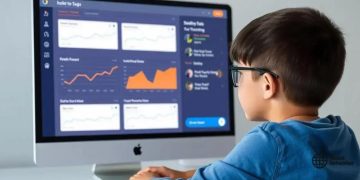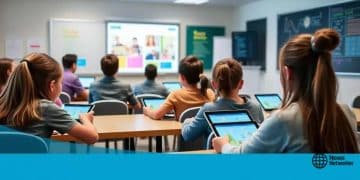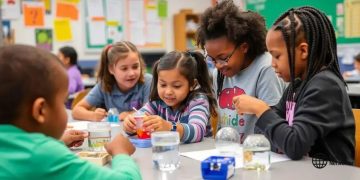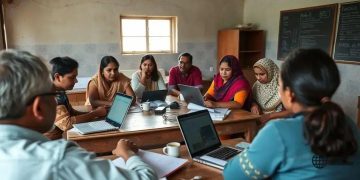The future of educational technology: trends to watch
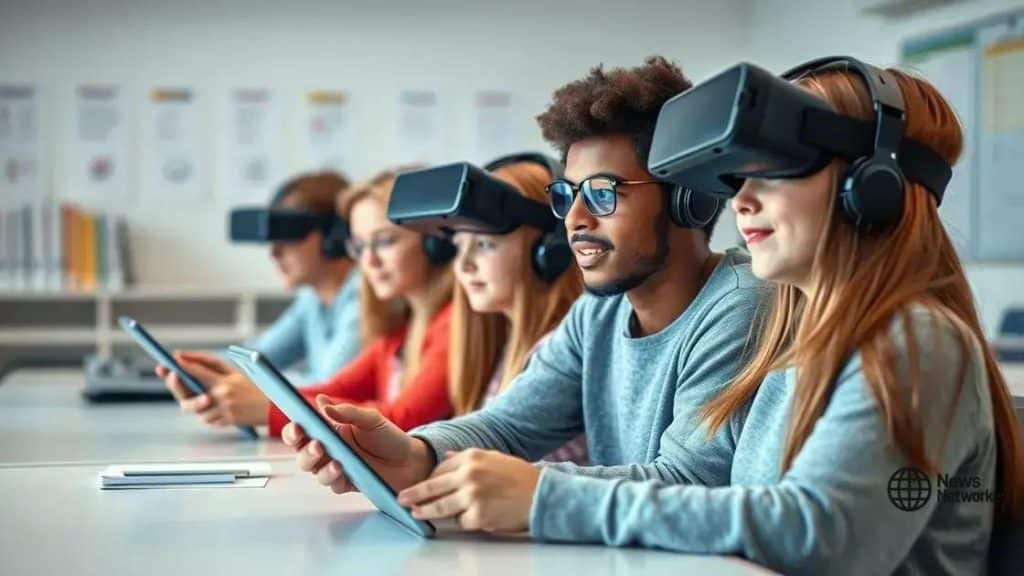
The future of educational technology emphasizes personalized learning, the integration of advanced tools like AI and VR, and a focus on developing essential skills for students to succeed in a rapidly changing world.
The future of educational technology is brimming with possibilities that can transform how we teach and learn. Have you ever wondered how these advancements can enhance your educational journey? Let’s dive into this evolving landscape.
Emerging technologies in education
Emerging technologies in education are changing how students learn and teachers instruct. These innovations are becoming essential tools that improve the educational experience.
Artificial Intelligence
One major advancement is artificial intelligence (AI). AI systems can offer personalized learning experiences, allowing students to progress at their own speed. By assessing each student’s abilities, AI adapts the curriculum to fit their needs.
Virtual Reality and Augmented Reality
Virtual reality (VR) and augmented reality (AR) are also transforming learning. With VR, students can explore virtual worlds, like ancient civilizations or the solar system, enriching their understanding through immersive experiences. AR, on the other hand, overlays digital information onto the real world, enhancing engagement and interactivity.
Benefits of New Technologies
- Increased student engagement
- Tailored learning experiences
- Real-time feedback for teachers and students
- Access to vast educational resources
Moreover, these technologies provide opportunities for remote learning, making education accessible to students in diverse locations. They also encourage collaboration among students, even when they are miles apart. This interconnectedness can introduce different perspectives and enhance the learning process.
As these technologies continue to advance, the potential for innovative learning solutions grows. Educational institutions must stay updated with these trends to prepare students for the future. Emerging technologies not only make learning more effective but also more enjoyable.
Personalized learning experiences
Personalized learning experiences are becoming a cornerstone of modern education. This approach tailors learning to meet the unique needs of each student, making education more effective and engaging.
What is Personalized Learning?
Personalized learning refers to adapting education to individual student strengths, weaknesses, and interests. This method helps students learn at their own pace and style, fostering a deeper understanding of the material.
Benefits of Personalized Learning
- Improved student engagement
- Higher retention of information
- Increased motivation to learn
- Better academic performance
With personalized learning, teachers can utilize various tools and resources. Online platforms often offer assessments that adapt to students’ skill levels, providing a customized path through the curriculum. This allows students to focus on areas where they need improvement while advancing faster in subjects they excel in.
Moreover, personalized learning encourages collaboration among peers. Students can engage in group work that enhances their learning experience. By sharing ideas and working together, they can gain new perspectives and insights. Educators play a vital role in this process by facilitating discussions and supporting collaborative projects.
As technology evolves, personalized learning continues to grow. Tools such as data analytics provide educators with insights into student progress. This data-driven approach allows for timely interventions, ensuring that no student falls behind while making every learning experience meaningful.
The role of AI in the classroom
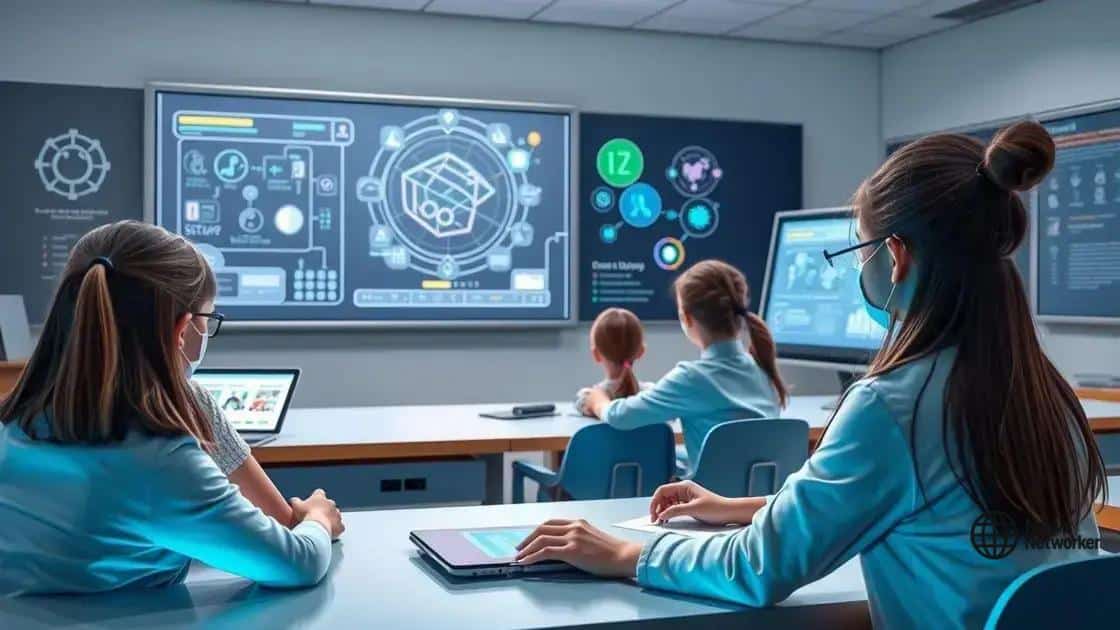
The role of AI in the classroom is increasingly important as educators look for ways to enhance learning. Artificial intelligence offers tools that can support both teachers and students.
AI-Powered Tools
AI can help teachers by automating administrative tasks. This allows them to spend more time focusing on student interactions. Programs can grade assignments and provide feedback quickly. This not only saves time but also ensures consistency in evaluation.
Personalized Learning Paths
With the help of AI, classrooms can create personalized learning experiences for students. AI systems can assess individual strengths and weaknesses. Based on this data, these systems can provide tailored content. This adjustment helps students understand concepts at their own pace.
Enhancing Engagement
- Interactive learning experiences through AI simulations
- Gamification to motivate students
- Real-time feedback and adaptive assessments
- Virtual assistants to answer student questions
AI also enhances student engagement. For example, using intelligent tutoring systems can provide support outside regular class hours. Students can ask questions and get instant responses, keeping them engaged even after school.
Moreover, AI tools can help identify students who may need additional support. This early intervention is crucial in ensuring all students have the opportunity to succeed. By analyzing learning patterns, AI can flag issues before they become significant problems.
Challenges in implementing new tech
Implementing new technology in education can be a challenging journey. While educational technology brings numerous benefits, various hurdles arise during its integration into classrooms.
Resistance to Change
One major challenge is resistance to change among educators and institutions. Many teachers may feel comfortable with traditional teaching methods, making them hesitant to adopt new tools. This reluctance can slow down the incorporation of technology in the learning environment.
Training and Support
Inadequate training for teachers is another obstacle. Without proper guidance and support, educators may struggle to use new technology effectively. Ongoing professional development is crucial to ensure that teachers can fully leverage digital tools.
Budget Constraints
- Lack of funding for necessary equipment
- High costs of software licenses
- Maintenance expenses
- Resource allocation for consistent updates
Budget constraints can also hinder the implementation of new tech. Schools often face limited funding, making it hard to invest in advanced resources. Financial limitations may result in outdated equipment or insufficient software licenses for all students.
Additionally, integrating technology into the curriculum requires careful planning. Educators must understand how to align tech tools with learning objectives. This alignment is essential to ensure that technology enhances, rather than disrupts, the educational process.
Finally, unequal access to technology can create disparities among students. While some have access to the latest devices and high-speed internet, others may lack these resources. This digital divide can limit the effectiveness of tech implementations across diverse classrooms.
Future predictions for educational methods
Future predictions for educational methods highlight the direction that learning is taking in modern society. With technological advancements, the way we teach and learn is rapidly evolving.
Increased Use of Technology
One major prediction is the increased use of technology in teaching methods. Virtual and augmented reality applications will offer immersive learning experiences. Students can explore historical sites or conduct scientific experiments in a virtual lab, making learning more engaging.
Focus on Skills Over Content
Future educational methods will likely emphasize skills over traditional content memorization. Critical thinking, creativity, and collaboration will become crucial in preparing students for the workforce. Schools may shift towards project-based learning where students tackle real-world problems.
Personalized Learning Environments
- Adaptive learning technologies tailoring content to individual students
- Flexible learning environments that allow for collaboration
- Access to global education resources through online platforms
As personalized learning continues to grow, classrooms will adapt to meet individual needs. Adaptive learning technologies will analyze student progress and provide tailored content and feedback. This shift will ensure that every student can learn at their pace and style.
Moreover, the rise of online education platforms will continue to provide learners with a wealth of resources. Students will have access to diverse materials and learning styles at their fingertips. This variety will allow for a more inclusive education system, accommodating different learning preferences.
The role of teachers will also evolve; they will become facilitators rather than just sources of information. Educators will guide students in navigating resources and developing essential skills for the future.
FAQ – Frequently Asked Questions about the Future of Educational Methods
What are the main benefits of personalized learning environments?
Personalized learning environments cater to individual students’ needs, allowing them to learn at their own pace and improving engagement.
How is technology shaping the future of education?
Technology introduces innovative tools like virtual reality, which creates immersive learning experiences, making education more engaging and accessible.
What skills will be emphasized in future educational methods?
Future educational methods will focus on critical thinking, creativity, and collaboration, preparing students for real-world challenges.
Why is it important to adapt teaching roles in classrooms?
Adapting teaching roles allows educators to become facilitators, guiding students in their learning process and helping them navigate resources effectively.
